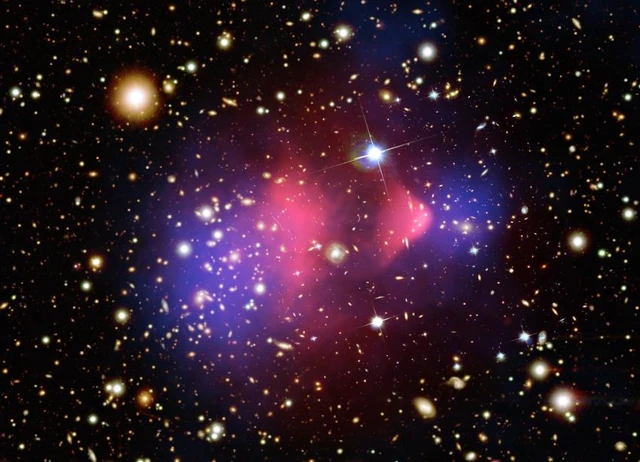
Image description: What do we see in this composite false-color image?
We see all the matter of the Bullet Cluster. The two galaxy clusters of the Bullet Cluster are in the blue area, and the two clouds of galactic gas are seen in X-rays, in red. The areas colored in blue represent most of the mass of the clusters, i.e., dark matter, six times more massive than ordinary matter. The Bullet Cluster is the smaller of the two clusters, the one that passes through the other (blue area on the right). The giant collision has "stripped" the two clusters of their gas halo, causing a shock wave visible at the tip of the small red spot. This shock wave strongly compressed and thus heated the cluster's gas to the point of reaching 100 million degrees. We can distinguish something like a bullet followed by its trail of gas. Credit: NASA CXC CfA.
The Bullet Cluster, also known as 1E 0657-56, is a famous galaxy cluster known for its spectacular collision between two smaller clusters. Located about 3.4 billion light-years away, this cluster has been studied in detail by the Hubble Space Telescope and the Chandra X-ray Observatory. Its name, "Bullet," refers to the distinctive shape of the cluster resulting from the collision.
The Bullet Cluster is composed of thousands of galaxies, hot gas, and dark matter. X-ray observations by Chandra have revealed that the hot gas, which represents most of the baryonic matter (visible), is separated from the dark matter. This separation is direct evidence of the existence of dark matter, as it does not interact with ordinary matter in the same way as hot gas.
Observations of the Bullet Cluster have allowed astronomers to use the gravitational lensing effect to map the distribution of dark matter. By observing the distortions in the images of background galaxies, scientists have been able to confirm the presence and distribution of dark matter in the cluster. This technique has been crucial for understanding the dynamics of the collision and the internal structure of the cluster.
Galaxy clusters are not only made up of galaxies; they are also immersed in cold gas of low density (about 1000 particles/m3) and hot gas reaching 10 to 100 million degrees. At these temperatures, the gas is fully ionized, forming a plasma visible in the X-ray domain.
The gas is distributed much more diffusely; it fills the space between galaxies and extends well beyond. The mass of the gas belonging to the cluster is much greater than the mass of the galaxies themselves. If we measure the gravitational dynamics of the Universe on a large scale, the mass of ordinary matter in the observable Universe represents only about 4% of the total mass. About 23% would correspond to dark matter and 73% to dark energy, as described in the SCDM (Standard Cold Dark Matter) model. What we observe through the light of stars, galaxies, and clusters corresponds only to ordinary matter.
All matter, ordinary and dark, is subject to the forces of the gravitational field. The Bullet Cluster or 1E 0657-56, observable in the constellation Carina, is the result of the collision of two galaxy clusters that occurred about 150 million years ago. The study of this collision, which began in August 2006, has provided one of the strongest observational proofs of the existence of dark matter.
When clusters collide, ordinary matter (stars, gas, and dust) is subject to gravitational forces. In reality, massive objects like stars almost never collide directly: interstellar space is immense, and stars pass by each other without meeting. They are not destroyed but can be slightly accelerated or decelerated by gravitational interaction.
On the other hand, during the collision, the cold and hot gases, which make up most of the baryonic mass of the clusters, interact strongly. These gases are abruptly slowed down, compressed, and mixed due to their diffuse nature, weak binding, and atomic freedom. This contrasting behavior is clearly visible in the composite images of the Bullet Cluster.
This gigantic collision between the two clusters released considerable energy. Observation in the X-ray domain provides fundamental insight into dark matter, as stars, gases, and dark matter react very differently to the gravitational shock.
The galaxies of the two clusters are observed in visible light and appear as multiple white spots. The hot gases are detected in the X-ray domain and appear as red clouds. Dark matter, on the other hand, is mapped indirectly by gravitational lensing and represented by diffuse blue light.
The image shows hundreds of galaxies grouped in clusters, with a small cluster visible in the blue spot on the right and a more massive cluster in the blue spot on the left. The associated gas envelopes appear in red. In reality, the small galaxy cluster has passed through the large cluster, leaving behind its strongly decelerated gas.
The collision literally "stripped" the clusters of their gaseous halo, generating a shock wave visible at the front of the small red spot. This shock wave compressed and heated the intra-cluster plasma to temperatures of about 100 million degrees. The Chandra X-ray Observatory locally measured gas displacement speeds reaching 4500 km/s.
The two clusters are now separated by about 3.4 billion light-years. The total mass deduced from their gravitational dynamics is much greater than the mass of observable ordinary matter (galaxies visible in optics and gas detected in X-rays). The regions colored in blue show the distribution of invisible dark matter.
During this titanic head-on collision, dark matter behaved like a negligible collisional component: it passed through the other cluster without significant interaction, unlike the interstellar gas, which was torn away and slowed down. This clear separation between dark matter and gas clouds constitutes direct and robust proof of the existence of dark matter.